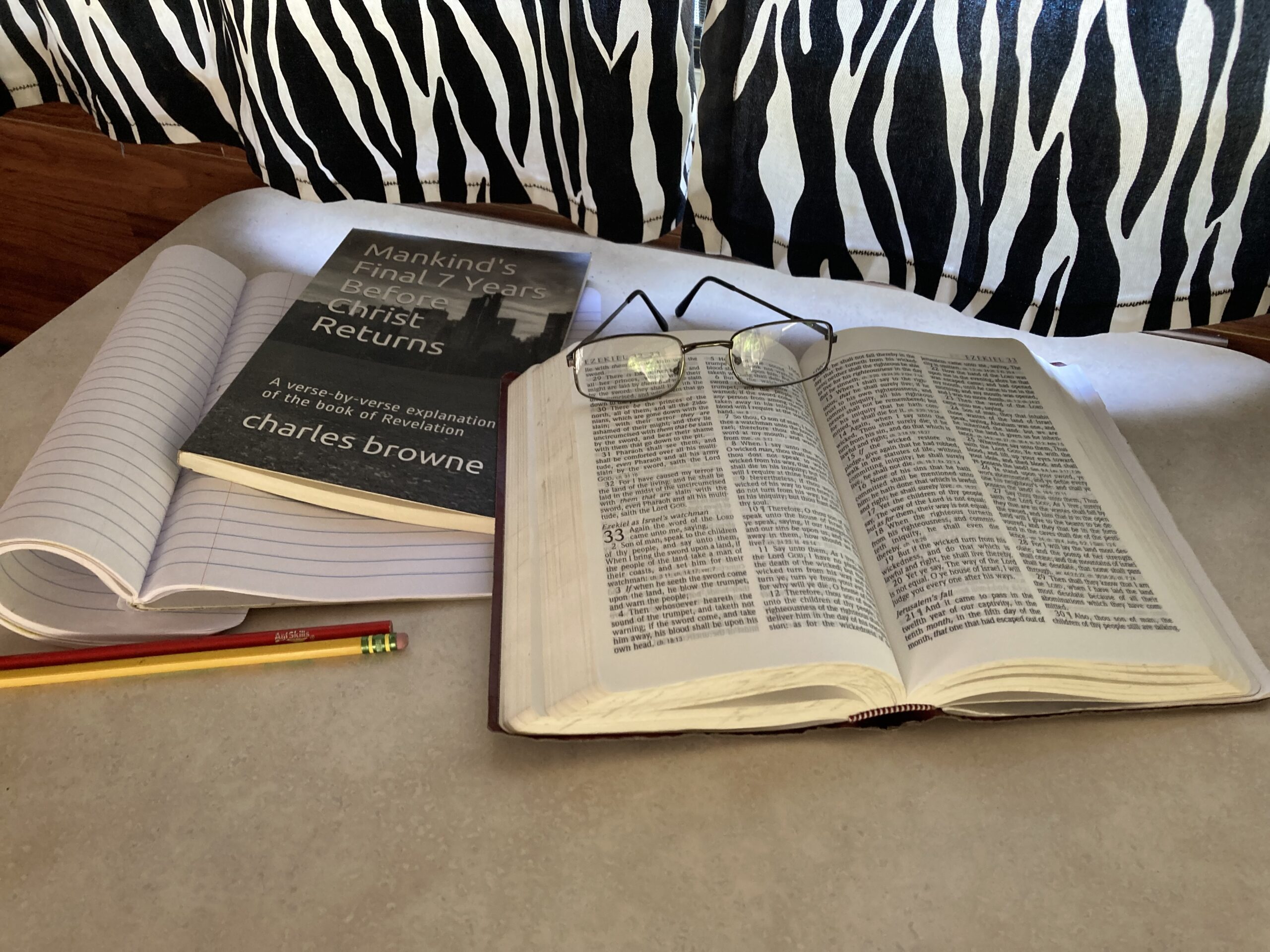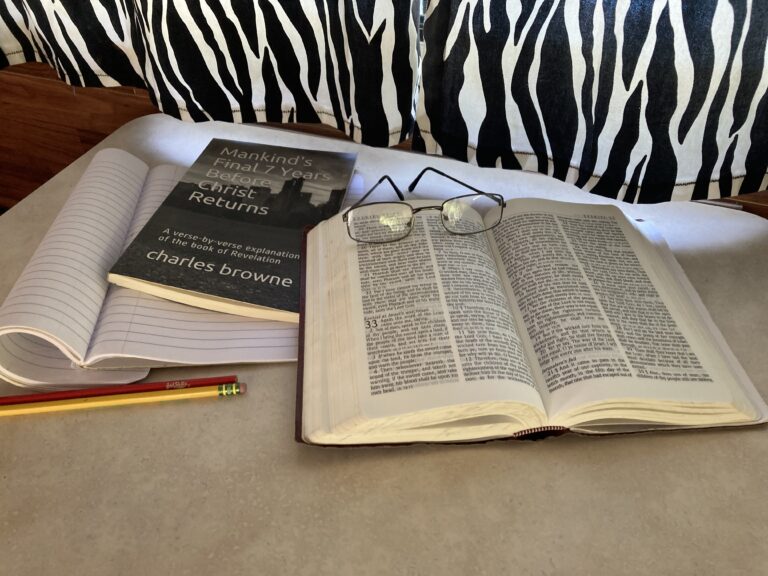THE BOOK OF REVELATION, Chapter 19
[This is an excerpt from my book, Mankind’s Final 7 Years Before Christ Returns: A verse-by-verse explanation of the book of Revelation]
19 And after these things I heard a great voice of much people in heaven, saying, Alleluia; Salvation, and glory, and honour, and power, unto the Lord our God:
“After these things” indicates a change in scene. We will now shift from the destruction of Babylon the Great, to the rejoicing which occurs in heaven. In the chronology of Revelation, this rejoicing appears to occur some time after the seventh bowl of wrath (Revelation 16:17-19).
2 For true and righteous are his judgments: for he hath judged the great whore, which did corrupt the earth with her fornication, and hath avenged the blood of his servants at her hand.
In chapter 18 the response of the kings and merchants, for the judging of the harlot, was mourning. The response in heaven is praising God for His righteous judgment.
3 And again they said, Alleluia And her smoke rose up for ever and ever.
Jerusalem will not literally burn forever, since it will be rebuilt during the millennial reign of Jesus Christ. As we saw in Revelation 14:11, the phrase “for ever and ever” in the Greek text means to the end of the age. So, Jerusalem will physically burn until the wrath of God is finished. Her spiritual partnership with the beast, however, will symbolically burn for eternity (see also- Isaiah 34:8-17).
4 And the four and twenty elders and the four beasts fell down and worshipped God that sat on the throne, saying, Amen; Alleluia.
5 And a voice came out of the throne, saying, Praise our God, all ye his servants, and ye that fear him, both small and great.
Since this event occurs after the rewarding of the saints, mentioned in Revelation 11:18, the phrase “small and great” probably refers to their status.
6 And I heard as it were the voice of a great multitude, and as the voice of many waters, and as the voice of mighty thunderings, saying, Alleluia: for the Lord God omnipotent reigneth.
7 Let us be glad and rejoice, and give honour to him: for the marriage of the Lamb is come, and his wife hath made herself ready.
Most other translations use the word “bride” rather than “wife”. In the original Greek, it could be either one. Technically, I believe, she is still the bride at this point. In chapter 21 she will be displayed as His wife.
8 And to her was granted that she should be arrayed in fine linen, clean and white: for the fine linen is the righteousness of saints.
9 And he saith unto me, Write, Blessed are they which are called unto the marriage supper of the Lamb. And he saith unto me, These are the true sayings of God.
The one speaking directly to John is not identified here, but is shown to be an angel in verse 10. This is probably the angel who began speaking to John in 17:1.
10 And I fell at his feet to worship him. And he said unto me, See thou do it not: I am thy fellowservant, and of thy brethren that have the testimony of Jesus: worship God: for the testimony of Jesus is the spirit of prophecy.
At this point, John has met many angels, yet never attempted to worship them. He is, apparently, so overcome by this message from God that he is compelled to worship the messenger. He will do so again, after receiving all the visions recorded in Revelation (Rev. 22:8-9).
It has been said that the gospel of Jesus Christ is at the core of every Old Testament prophecy. (See also- John 5:39)
11 And I saw heaven opened, and behold a white horse; and he that sat upon him was called Faithful and True, and in righteousness he doth judge and make war.
The words “and I saw” signify a new setting. This vision is the first, in a series of seven visions, which John will see concerning God’s judgment. These seven visions will be in chronological order.
The rider, of the white horse, is clearly identified as Jesus Christ, in this verse and those those following. Also, His immediate purpose is stated. He will judge and defeat the beast and its followers (see also- Isaiah 24).
12 His eyes were as a flame of fire, and on his head were many crowns; and he had a name written, that no man knew, but he himself.
This is the third reference to Jesus having eyes like a flame of fire (see also- Revelation 1:14; 2:18). A crown symbolizes authority. Here, Jesus is shown with many crowns. In Matthew 28:18, Jesus said that ALL power had been given to Him, in heaven and earth.
Jesus is referred to, in the Bible, by many names and titles. He also has a name which no one knows.
13 And he was clothed with a vesture dipped in blood: and his name is called The Word of God.
This is, symbolically, speaking of the blood of His vanquished enemies (Isaiah 63:1-4; Rev. 14:20). It is also, I believe, the redeeming blood shed by Jesus at the cross, as He could not righteously judge the unbelievers if salvation had not been offered to them.
14 And the armies which were in heaven followed him upon white horses, clothed in fine linen, white and clean.
The identity of the armies, which were in heaven, is subject to debate. There are a number of verses, in both the old and new testaments, which state that angels will accompany Jesus at His return. Also, angels are often referred to as the armies of God. There are no verses, in the Bible, which refer to believers being the army of God, but 1 Thessalonians 4:13-17 says that believers will also accompany Jesus at His second coming.
The clothing of the armies symbolizes their righteousness (Rev. 19:8).
15 And out of his mouth goeth a sharp sword, that with it he should smite the nations: and he shall rule them with a rod of iron: and he treadeth the winepress of the fierceness and wrath of Almighty God.
Jesus will not actually have a sword sticking out of His mouth. The sword symbolizes the word of God (Hebrews 4:12: Ephesians 6:17), and Jesus was literally called the word of God in verse 13 (see also Revelation 1:16; 2:12, 16).
That Jesus rules the nations with a rod of iron, refers back to Revelation 12:5 where the male child, born of the woman (Israel), would rule with a rod of iron. Many people believe the rod of iron symbolizes that Jesus will beat the nations into submission, but that is not true. A shepherd had two tools- a rod and a staff. The staff was for leading, and the rod for protecting. A rod of iron symbolizes extreme protection. Some of this protection involves punishing, and removing, the wicked from the earth. Revelation 2:27 states also that Christians, who overcome, will rule with a rod of iron.
Treading the winepress of the wrath of God symbolizes how Jesus will smite the nations before ruling over them (see also- Isaiah 29:5-7). This also relates to Revelation 11:5, where we learned that many unbelievers would enter the earthly kingdom of Jesus Christ.
16 And he hath on his vesture and on his thigh a name written, King Of Kings, And Lord Of Lords.
Despite the fact that verse 12 said that Jesus had a name that no one knew, this is the second name attributed to Jesus in this chapter. His many crowns refer to His many areas of authority, and thus, to His many titles or names.
17 And I saw an angel standing in the sun; and he cried with a loud voice, saying to all the fowls that fly in the midst of heaven, Come and gather yourselves together unto the supper of the great God;
This is the second in the series of seven visions. And I saw” does not really indicate a new scene, but rather an addition to the present scene.
In Ezekiel 39:17-20, God instructs Ezekiel to call the birds to a great feast much like this one.
18 That ye may eat the flesh of kings, and the flesh of captains, and the flesh of mighty men, and the flesh of horses, and of them that sit on them, and the flesh of all men, both free and bond, both small and great.
This wide array of humanity indicates that no segment of society will be spared from the slaughter. It should be remembered, however, that not everyone will be there, but only the beast and his followers.
19 And I saw the beast, and the kings of the earth, and their armies, gathered together to make war against him that sat on the horse, and against his army.
“And I saw” signifies another change in the setting. This is the third vision, in the series of seven. John is seeing the sixth bowl fulfilled (Rev. 16:16), as the beast gathers the nations to war against Jesus Christ. Some people suggest that there are two battles here- one described in verses 15-18, and the other in verses 19-21. The birds are called, however, in verses 17-18, and don’t eat until verse 21.
20 And the beast was taken, and with him the false prophet that wrought miracles before him, with which he deceived them that had received the mark of the beast, and them that worshipped his image. These both were cast alive into a lake of fire burning with brimstone.
Some verses, in the Bible, seem to imply that the Antichrist will be destroyed immediately at the second coming of Jesus. This verse, however, is speaking of the beast-kingdom and the coalition of two kingdoms that comprise the false prophet (Revelation 13:11). This is symbolic of their destruction. Matthew 25:41-46 shows that their followers will join them after the sheep and goat judgment. (See also- Daniel 7:23-26; 8:23-25; 11:36-45)
Hell is often associated, in the Bible, with unquenchable fire, but only in Revelation is it described as a lake of fire.
21 And the remnant were slain with the sword of him that sat upon the horse, which sword proceeded out of his mouth: and all the fowls were filled with their flesh.
This verse clearly shows that, unlike the beast and false prophet, the followers of the beast will die a physical death. Zechariah 14:12 adds these details- “And this shall be the plague wherewith the Lord will smite all the people that have fought against Jerusalem; Their flesh shall rot away while they stand upon their feet, and their eyes shall rot away in their holes, and their tongue shall rot away in their mouth.”



2 Comments